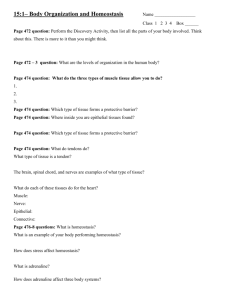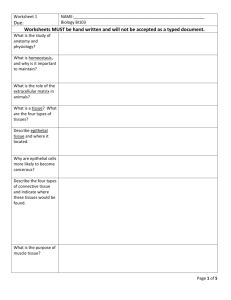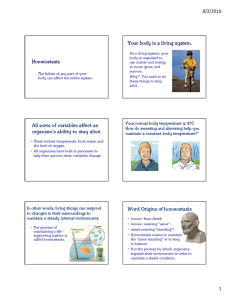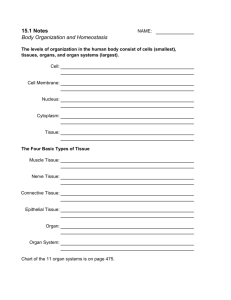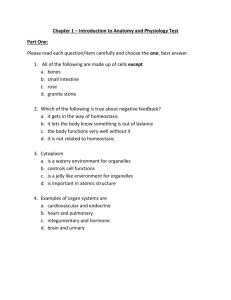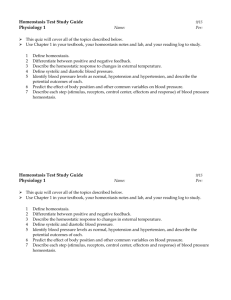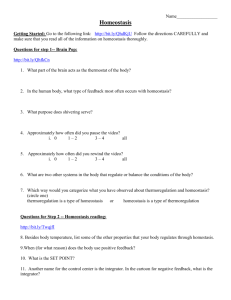Homeostasis
advertisement
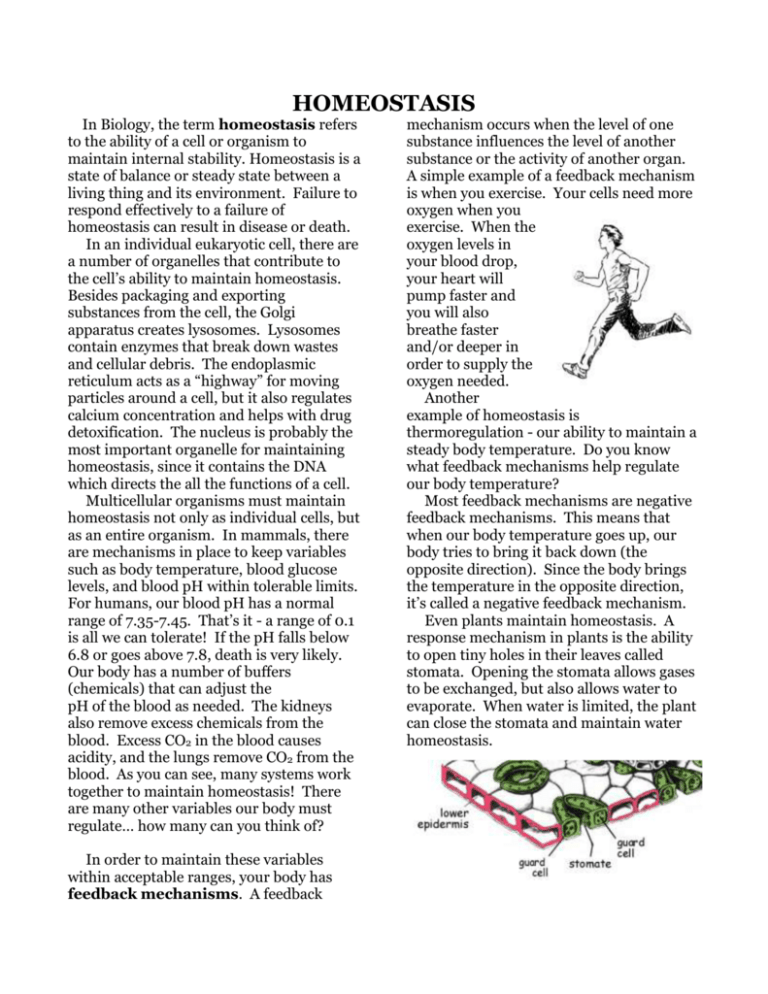
HOMEOSTASIS In Biology, the term homeostasis refers to the ability of a cell or organism to maintain internal stability. Homeostasis is a state of balance or steady state between a living thing and its environment. Failure to respond effectively to a failure of homeostasis can result in disease or death. In an individual eukaryotic cell, there are a number of organelles that contribute to the cell’s ability to maintain homeostasis. Besides packaging and exporting substances from the cell, the Golgi apparatus creates lysosomes. Lysosomes contain enzymes that break down wastes and cellular debris. The endoplasmic reticulum acts as a “highway” for moving particles around a cell, but it also regulates calcium concentration and helps with drug detoxification. The nucleus is probably the most important organelle for maintaining homeostasis, since it contains the DNA which directs the all the functions of a cell. Multicellular organisms must maintain homeostasis not only as individual cells, but as an entire organism. In mammals, there are mechanisms in place to keep variables such as body temperature, blood glucose levels, and blood pH within tolerable limits. For humans, our blood pH has a normal range of 7.35-7.45. That’s it - a range of 0.1 is all we can tolerate! If the pH falls below 6.8 or goes above 7.8, death is very likely. Our body has a number of buffers (chemicals) that can adjust the pH of the blood as needed. The kidneys also remove excess chemicals from the blood. Excess CO2 in the blood causes acidity, and the lungs remove CO2 from the blood. As you can see, many systems work together to maintain homeostasis! There are many other variables our body must regulate… how many can you think of? In order to maintain these variables within acceptable ranges, your body has feedback mechanisms. A feedback mechanism occurs when the level of one substance influences the level of another substance or the activity of another organ. A simple example of a feedback mechanism is when you exercise. Your cells need more oxygen when you exercise. When the oxygen levels in your blood drop, your heart will pump faster and you will also breathe faster and/or deeper in order to supply the oxygen needed. Another example of homeostasis is thermoregulation - our ability to maintain a steady body temperature. Do you know what feedback mechanisms help regulate our body temperature? Most feedback mechanisms are negative feedback mechanisms. This means that when our body temperature goes up, our body tries to bring it back down (the opposite direction). Since the body brings the temperature in the opposite direction, it’s called a negative feedback mechanism. Even plants maintain homeostasis. A response mechanism in plants is the ability to open tiny holes in their leaves called stomata. Opening the stomata allows gases to be exchanged, but also allows water to evaporate. When water is limited, the plant can close the stomata and maintain water homeostasis. Name:_____________________________Period:_________ Biology I Homeostasis Questions 1. What is homeostasis? ________________________________________________ _________________________________________________________________ _________________________________________________________________ 2. Name an organelle that helps the cell maintain homeostasis:______________________ How does it help maintain homeostasis? ___________________________________ _________________________________________________________________ _________________________________________________________________ 3. Human red blood cells eject their nucleus before they begin circulating in your bloodstream and also lack organelles. They are also among your body’s shortest lived cells, living only 100120 days (the average is 7-10 years for most of your cells). Explain why red blood cells are short-lived. _________________________________________________________ _________________________________________________________________ _________________________________________________________________ _________________________________________________________________ 4. The article mentions variables such as body temperature, blood glucose levels, and blood pH. These all need to be maintained at constant levels. List at least three other variables your body regulates: _________________________________________________________________ _________________________________________________________________ _________________________________________________________________ 5. What is a feedback mechanism?_________________________________________ _________________________________________________________________ _________________________________________________________________ 6. What feedback mechanisms help you regulate your body temperature?_______________ _________________________________________________________________ _________________________________________________________________ _________________________________________________________________ 7. Why can’t plants just keep their stomata closed? Then they wouldn’t have to worry about losing too much water. Explain why they have to be open: _________________________ _________________________________________________________________ _________________________________________________________________ 8. Write a conclusion paragraph for this article. It seems to be missing. _________________________________________________________________ _________________________________________________________________ _________________________________________________________________ _________________________________________________________________ _________________________________________________________________ Name:_____________________________Period:______ Biology I Honors Homeostasis Questions 1. What is homeostasis? ________________________________________________ _________________________________________________________________ _________________________________________________________________ 2. Name an organelle not mentioned in the article that helps the cell maintain homeostasis:______________________How does it help maintain homeostasis?______ _________________________________________________________________ _________________________________________________________________ _________________________________________________________________ 3. Human red blood cells eject their nucleus before they begin circulating in your bloodstream and also lack organelles. They are also among your body’s shortest lived cells, living only 100120 days (the average is 7-10 years for most of your cells). Explain why red blood cells are short-lived. _________________________________________________________ _________________________________________________________________ _________________________________________________________________ _________________________________________________________________ 4. The article mentions variables such as body temperature, blood glucose levels, and blood pH. These all need to be maintained at constant levels. List at least three other variables your body regulates: _________________________________________________________________ _________________________________________________________________ _________________________________________________________________ 5. What is a feedback mechanism?_________________________________________ _________________________________________________________________ _________________________________________________________________ 6. What feedback mechanisms help you regulate your body temperature?_______________ _________________________________________________________________ _________________________________________________________________ _________________________________________________________________ 7. Differentiate between a negative feedback mechanism and a positive feedback mechanism: _________________________________________________________________ _________________________________________________________________ _________________________________________________________________ _________________________________________________________________ _________________________________________________________________ 8. When your blood glucose gets too high, your pancreas releases insulin to help bring the levels down. Is this an example of a negative feedback mechanism? ________ Explain:____ _________________________________________________________________ _________________________________________________________________ 9. Blood clotting is initiated when injured tissue releases signal chemicals that activate platelets in the blood. An activated platelet releases chemicals to activate more platelets, causing a rapid cascade and the formation of a blood clot. Is this an example of a negative feedback mechanism?____________ Explain:______________________________________ _________________________________________________________________ 10. Is positive feedback a mechanism for maintaining homeostasis? ________ Explain your answer:___________________________________________________________ _________________________________________________________________ _________________________________________________________________ _________________________________________________________________ _________________________________________________________________ _________________________________________________________________ 11. Why can’t plants just keep their stomata closed? Then they wouldn’t have to worry about losing too much water. Explain why they have to be open: _________________________ _________________________________________________________________ _________________________________________________________________ 12. Write a conclusion paragraph for this article. It seems to be missing. _________________________________________________________________ _________________________________________________________________ _________________________________________________________________ _________________________________________________________________ _________________________________________________________________ _________________________________________________________________ _________________________________________________________________ _________________________________________________________________ Questions
